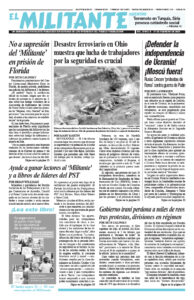Amid rising tensions between the capitalist rulers in the U.S. and China, Washington tracked and then shot down a Chinese balloon Feb. 4, saying it was spying on U.S. territory after it flew over North America.
For years the U.S. rulers have sought to contain the rulers of China and especially limit their acquisition of military technology. Washington views their growing economic, political and military clout as a challenge to its decadeslong supremacy in the Pacific, the biggest prize it won when it came out of the second imperialist world war as top dog.
Beijing is asserting its right to take over the self-governing island of Taiwan, if necessary by force, and has expanded its military footholds in the South China Sea. To counter this, the U.S. rulers are reinforcing alliances with capitalist powers in the region and expanding their own military footprint. President Joseph Biden has made clear that Washington will respond militarily to any aggression from Beijing aimed at Taiwan.
The balloon — which Beijing initially claimed was a weather airship — appeared in U.S. airspace over Alaska Jan. 28 and U-2 spy planes were sent to examine it. As it passed over military installations, Republicans demanded Biden shoot it down. He did so after the balloon crossed the Atlantic coastline. Tensions in Washington-Beijing relations, already at a high point, sharpened.
Beijing claims the balloon had blown off course and accuses the White House of the “indiscriminate use of military force.” Washington says sending the balloon was a violation of U.S. sovereignty and “international law.” Yet the U.S. rulers themselves scan the entire world with a massive array of satellites and other tools for spying on their rivals.
After World War II, the U.S. rulers planned to send troops to back ally Chiang Kai-Shek’s war against Mao Zedong’s peasant army and open up China to profit-hungry U.S. investors. That plan was foiled by hundreds of thousands of U.S. troops stationed in the Pacific who refused to fight, demanding Washington bring them home.
Mao’s army took power in 1949 and was pressured to overturn capitalism as Washington invaded Korea. His regime was a copy of Joseph Stalin’s counterrevolutionary government in the Soviet Union. It broke with Moscow in the 1960s over their irreconcilable national interests.
After Mao’s death, the ruling Chinese Communist Party turned toward capitalist market production, overseeing a massive growth of industry and trade.
Today the growth rate of the Chinese capitalist economy has fallen to its slowest since the 1970s. The population has also declined for the first time in 60 years. Beijing recently abandoned its brutal “zero-COVID” lockdowns after unprecedented protests. Like the U.S. and other rival powers, the Chinese rulers also face strikes and growing resistance by working people at home.
Despite Beijing’s increasing weight in the region, Washington has advantages in the conflict over which power will dominate, including the size of the U.S. economy and its vast military might.
The Biden White House has tightened sanctions imposed by former President Donald Trump to block Chinese companies from obtaining semiconductors and manufacturing technology that can also be used by Beijing’s fast-growing military.
US military expands across Pacific
The U.S. rulers are expanding their military presence and alliances around the Pacific. Washington backs the Japanese government’s decision to embark on its biggest military buildup since World War II. The U.S. rulers are reactivating a mobile Marine base on Guam and increasing their military aid to the rulers of South Korea.
Washington made a pact with the government of the Philippines Feb. 9 for the U.S. military to have access to four additional bases there — in the north, facing Taiwan, and in the west facing the South China Sea. This arrangement doesn’t include the huge air and naval facilities, Clark and Subic Bay, that Washington was forced to relinquish in the early 1990s. Mobilizations of Filipino working people, who had toppled the U.S.-backed dictatorship of Ferdinand Marcos a few years before, had demanded that the U.S. former colonial masters get out.
Rodrigo Duterte, the Philippine president from 2016 to 2022, sought closer relations with Beijing, hoping to shield the interests of Filipino capitalists in fishing, mineral and other resources in the South China Sea. The Chinese military has fortified 10 artificial island outposts there since 2014, including one that is inside the Philippines exclusive economic zone.
Now under President Ferdinand Marcos Jr., the Philippine government has tilted back toward Washington to try to counter Beijing.
The Australian imperialist rulers want a closer alliance with Washington as they also face Beijing’s assertiveness. They have agreed to let an Australian air force base in the continent’s north host U.S. B-52 bombers.
In 2021, Washington, London and Canberra formed a new defense pact, AUKUS, establishing closer military collaboration and technology sharing. Under its terms Washington will assure the Australian navy gets nuclear-powered submarines. The U.S. rulers also sponsor the Asian and Pacific-based QUAD military alliance with the governments of Australia, India and Japan.
The U.S. Navy and Marine Corps began scheduled joint exercises in the South China Sea Feb. 11. Some 30% of world trade, valued at $5.3 trillion a year, goes through those waters. Beijing responded by sending its warships and planes into the waters and airspace around Taiwan. Beijing claims most of that sea, which is subjected to various counter claims by other capitalist governments from Vietnam and the Philippines to Malaysia, Indonesia and Taiwan.


